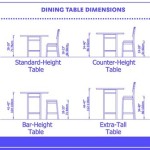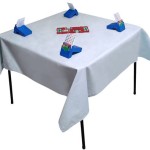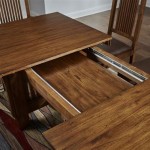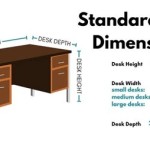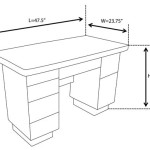Tables, Chairs, and Workstations: A Comprehensive Guide to Optimizing Workspace Environments
The modern workspace, whether a bustling corporate office, a compact home office, or a collaborative co-working space, relies heavily on the fundamental components of tables, chairs, and workstations. These elements, when thoughtfully selected and strategically arranged, can significantly impact employee productivity, well-being, and overall organizational success. Understanding the various types, features, and considerations involved in choosing these essential pieces of furniture is crucial for creating an environment that fosters efficiency and comfort.
Ignoring the significance of well-designed tables, chairs, and workstations can lead to a variety of negative consequences. Poor ergonomics can result in musculoskeletal disorders, decreased focus, and increased absenteeism. An uninspiring or inefficient workspace can hinder collaboration, creativity, and overall morale. Therefore, a deliberate and informed approach to selecting these furnishings is a wise investment in the human capital and operational effectiveness of any organization.
Understanding the Importance of Ergonomics
Ergonomics, the science of designing workspaces to fit the needs of the people using them, is paramount when choosing tables, chairs, and workstations. The goal is to minimize physical strain and discomfort, thereby promoting health and productivity. This involves considering factors such as posture, reach, and repetition, and selecting furniture that can be adjusted to accommodate the individual needs of each user.
An ergonomically sound chair, for example, should provide adequate lumbar support, adjustable seat height and depth, and adjustable armrests. A well-designed table should offer sufficient surface area for tasks without requiring excessive reaching, and a workstation should be configured to minimize awkward postures and repetitive movements. Investing in ergonomic assessments and training can further enhance the benefits of ergonomic furniture, ensuring that employees are properly educated on how to adjust and use their equipment for optimal comfort and support.
The principles of ergonomics extend beyond mere comfort; they directly contribute to long-term health and well-being. By reducing the risk of musculoskeletal disorders like carpal tunnel syndrome, back pain, and neck strain, ergonomic furniture can decrease healthcare costs and improve employee retention. A proactive approach to ergonomics demonstrates a commitment to employee well-being, fostering a positive and supportive work environment.
Exploring Different Types of Tables
Tables serve diverse purposes in the workspace, ranging from individual workstations to collaborative meeting areas. The ideal type of table will depend on its intended use and the specific needs of the individuals who will be using it. Understanding the various options available is essential for making informed decisions.
Individual workstations often utilize rectangular or L-shaped tables providing ample personal space within a larger open office environment. These tables are typically designed with considerations for cable management and monitor placement. Adjustable height tables, also known as sit-stand desks, are gaining popularity due to their ability to promote movement and reduce sedentary behavior throughout the workday. The ability to alternate between sitting and standing can improve circulation, reduce back pain, and increase energy levels.
For collaborative spaces, round or oval tables encourage communication and teamwork. Conference tables, designed to accommodate larger groups, come in various shapes and sizes, and often feature built-in power and data connectivity. Breakroom tables provide a casual setting for employees to relax and socialize, fostering a sense of community. In specialized environments, such as laboratories or design studios, specialized tables with specific features, such as chemical resistance or drafting capabilities, are necessary.
Material selection also plays a crucial role in the durability and aesthetics of a table. Wood tables offer a classic and warm aesthetic, while metal tables provide a more modern and industrial look. Laminate tables are a cost-effective and durable option, while glass tables add a touch of elegance. The choice of material should be based on the overall design of the workspace and the specific requirements of the task at hand.
Chair Selection: Beyond Simple Seating
The chair is arguably the most critical piece of furniture in the workspace, as it directly impacts the user's posture and comfort for extended periods. Selecting the right chair requires careful consideration of ergonomic features, adjustability, and durability.
Office chairs typically feature adjustable height, back support, armrests, and tilt mechanisms. These adjustments allow users to customize the chair to fit their individual body type and work style. Lumbar support is particularly important for maintaining proper spinal alignment and preventing back pain. Adjustable armrests can reduce strain on the shoulders and neck.
Task chairs are designed for intensive use and offer enhanced ergonomic features, such as forward tilt and adjustable seat depth. Executive chairs provide a more luxurious and comfortable seating experience, often featuring leather upholstery and a higher backrest. Mesh chairs offer breathability and ventilation, making them ideal for warm climates. Specialized chairs, such as kneeling chairs or saddle chairs, promote an upright posture and engage core muscles.
Beyond ergonomic features, the durability of a chair is also important. High-quality chairs are constructed with durable materials and sturdy frames, ensuring that they can withstand the rigors of daily use. The upholstery should be resistant to stains and wear, and the chair should be easy to clean and maintain.
Workstations: Designing for Functionality and Collaboration
The workstation encompasses the entire workspace assigned to an individual, including the table, chair, storage, and accessories. A well-designed workstation optimizes functionality, promotes collaboration, and enhances employee well-being.
Open-plan workstations, also known as cubicles or pods, provide a degree of privacy while still allowing for communication and collaboration. These workstations often feature panels or screens to reduce distractions and create a sense of personal space. Modular workstations offer flexibility and can be easily reconfigured to accommodate changing needs. Height-adjustable workstations allow employees to alternate between sitting and standing, promoting movement and reducing sedentary behavior.
Private offices offer a more secluded and focused work environment. These offices typically feature a desk, chair, storage cabinets, and other furnishings. The design of a private office should reflect the individual's work style and role within the organization.
Collaborative workstations are designed to facilitate teamwork and communication. These workstations often feature shared tables, whiteboards, and other tools that encourage interaction. The layout of a collaborative workstation should promote open communication and easy access to shared resources.
Effective cable management is crucial for maintaining a clean and organized workstation. Cables can be routed through grommets, trays, or other cable management systems to prevent tangling and tripping hazards. Proper lighting is also essential for reducing eye strain and improving productivity. Task lighting, such as desk lamps, can provide focused illumination for specific tasks.
Material Selection Considerations
The materials used in tables, chairs, and workstations impact their durability, aesthetics, and environmental impact. Selecting sustainable and durable materials is a key consideration for creating a responsible and long-lasting workspace.
Wood is a popular choice for tables and desks due to its natural beauty and durability. Solid wood offers the highest quality and longevity, while engineered wood products, such as plywood and particleboard, provide a more cost-effective alternative. Sustainable wood sources, such as FSC-certified wood, ensure that the wood is harvested from responsibly managed forests.
Metal is a durable and versatile material that is often used in chair frames, table legs, and workstation components. Steel is a strong and cost-effective option, while aluminum is lightweight and corrosion-resistant. Recycled metal content is another factor to consider when choosing metal furniture.
Plastics are commonly used in chair shells, armrests, and other components. Recycled plastics offer a sustainable alternative to virgin plastics. Fabric upholstery can be made from a variety of materials, including natural fibers, synthetic fibers, and recycled fibers. The choice of fabric should consider durability, stain resistance, and comfort.
The Role of Color and Aesthetics
Color and aesthetics play a significant role in creating a positive and productive work environment. The colors used in tables, chairs, and workstations can influence mood, focus, and creativity.
Neutral colors, such as white, gray, and beige, provide a calming and professional backdrop. These colors can be easily paired with pops of color to add visual interest. Warm colors, such as yellow, orange, and red, can create a stimulating and energizing environment. Cool colors, such as blue, green, and purple, can promote relaxation and focus.
The overall aesthetic of the workspace should align with the company's brand and culture. Modern and minimalist designs emphasize clean lines and simplicity. Traditional designs feature classic shapes and rich materials. Industrial designs incorporate raw materials and exposed elements.
Integrating plants and natural elements into the workspace can improve air quality and create a more inviting atmosphere. Biophilic design principles, which emphasize the connection between humans and nature, can be incorporated into the selection of tables, chairs, and workstations to create a more restorative and productive environment.
Maintenance and Longevity
Proper maintenance is essential for extending the lifespan of tables, chairs, and workstations. Regular cleaning and inspection can prevent premature wear and tear.
Tables and desks should be cleaned regularly with a mild soap and water solution. Avoid using harsh chemicals or abrasive cleaners that can damage the finish. Chairs should be vacuumed regularly to remove dust and debris. Upholstery stains should be treated promptly with a stain remover. Metal components should be wiped down with a damp cloth to prevent corrosion.
Periodic inspections should be conducted to identify any signs of damage or wear. Loose screws should be tightened, and worn parts should be replaced. Height-adjustable mechanisms should be lubricated regularly to ensure smooth operation.
Investing in high-quality furniture from reputable manufacturers is a key to ensuring longevity. High-quality furniture is typically constructed with durable materials and sturdy frames, making it more resistant to wear and tear. Warranties provide added protection against defects and premature failure.

Quad Desk 4 Person Branch Office Furniture

Open Plan Workstation Planning And Design Knoll

Open Plan Workstation Planning And Design Knoll

Open Plan Workstation Planning And Design Knoll

Open Plan Workstation Planning And Design Knoll

Office Workstations

Office Partitions Dividers And Privacy Curtains Modular Solutions For A Modern

Desks And Workspaces Herman Miller

Office Furniture Workstations Desks Cubicles Benching Jci

Antenna Tables And Desks Knoll

